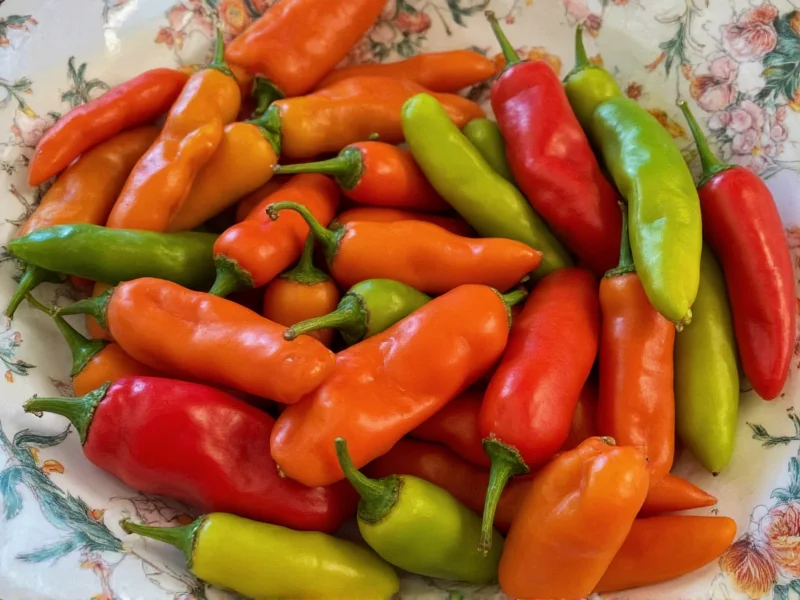Understanding the heat level of pasilla peppers is essential for home cooks and culinary enthusiasts seeking the perfect balance of flavor and spice. These dried chilaca peppers, often mistaken for poblanos (which are actually a different variety), offer a distinctive taste profile that enhances traditional Mexican dishes without overwhelming heat.
What Are Pasilla Peppers?
Pasilla peppers (chile pasilla) are the dried form of fresh chilaca peppers. The name "pasilla" means "little raisin" in Spanish, referring to their dark color and sweet, fruity flavor when dried. They're one of Mexico's "holy trinity" of chiles, alongside ancho and mulato peppers.
Visually, pasilla peppers appear as long, slender, dark brown to black dried peppers with wrinkled skin. Their flavor profile combines earthy notes with hints of berries, tobacco, and licorice, making them prized for complex sauces like mole.
Measuring Pepper Heat: The Scoville Scale
The Scoville scale measures capsaicin concentration—the compound responsible for heat in peppers. Developed by Wilbur Scoville in 1912, it quantifies heat in Scoville Heat Units (SHU). Modern testing uses high-performance liquid chromatography for precise measurements.
Understanding where pasilla peppers fall on this scale helps cooks manage heat levels in recipes. At 1,000–2,500 SHU, they sit comfortably in the mild category, comparable to banana peppers but milder than the more familiar jalapeño.
Pasilla Pepper Heat Comparison Chart
| Pepper Variety | Scoville Heat Units (SHU) | Heat Level |
|---|---|---|
| Pasilla | 1,000–2,500 | Mild |
| Jalapeño | 2,500–8,000 | Medium |
| Serrano | 10,000–23,000 | Medium-Hot |
| Habanero | 100,000–350,000 | Very Hot |
| Poblano (fresh) | 1,000–2,000 | Mild |
How Pasilla Peppers Compare to Common Varieties
When considering how hot are pasilla peppers compared to jalapeño, the difference is significant. A typical jalapeño ranges from 2,500–8,000 SHU—up to eight times hotter than the mildest pasilla. This makes pasilla peppers an excellent choice for those who enjoy flavor without intense heat.
Many confuse pasilla peppers with poblanos, but they're distinct varieties. Poblanos are fresh peppers that become anchos when dried. Pasillas come from chilacas. While their heat levels overlap (poblanos: 1,000–2,000 SHU), their flavor profiles differ significantly. Understanding this pasilla vs poblano heat difference prevents recipe mishaps.
Culinary Applications of Pasilla Peppers
The moderate heat level of pasilla peppers makes them incredibly versatile in cooking. Chefs value them for:
- Sauces and moles: Their earthy flavor forms the base of complex sauces without overwhelming heat
- Stews and braises: They add depth to dishes like chile colorado
- Marinades: Their mild heat penetrates proteins without burning
- Blends: Often combined with hotter peppers to balance heat and flavor
When working with dried pasillas, rehydration is key. Soak them in hot water for 20 minutes before use to restore flexibility and enhance flavor extraction. Removing seeds reduces heat slightly, though pasillas contain relatively few seeds compared to hotter varieties.
Substituting Pasilla Peppers
If you're wondering are pasilla peppers spicy enough for your recipe or need alternatives, consider these substitutions:
- Ancho peppers: Dried poblanos with similar heat (1,000–2,000 SHU) but fruitier flavor
- Guajillo peppers: Slightly hotter (2,500–5,000 SHU) with tangy notes
- Mulato peppers: Similar heat with chocolatey undertones
- Combination: Mix bell peppers with a pinch of cayenne for approximate heat level
For authentic Mexican cuisine, maintaining the specific flavor profile matters more than exact heat replication. When seeking the best substitute for pasilla peppers, consider both heat and flavor characteristics.
Growing and Selecting Pasilla Peppers
Fresh chilaca peppers (which become pasillas when dried) grow well in warm climates with long growing seasons. They mature from dark green to deep brown, eventually turning black when fully dried.
When selecting dried pasillas, look for:
- Deep, uniform dark brown to black color
- Flexible texture (avoid brittle, broken peppers)
- Shiny surface indicating proper drying
- Rich, raisin-like aroma
Store dried pasillas in airtight containers away from light and moisture. Properly stored, they maintain quality for 6–12 months. For extended storage, freeze them in vacuum-sealed bags.
Common Questions About Pasilla Pepper Heat
Understanding the precise pasilla pepper heat level scoville measurement helps cooks make informed decisions. Their position on the milder end of the spectrum makes them accessible to most palates while still providing characteristic chile flavor.
When exploring mild pepper varieties for cooking, pasillas stand out for their complex flavor profile beyond just heat measurement. Their earthy, nearly smoky notes add dimension to dishes where pure heat would be undesirable.











 浙公网安备
33010002000092号
浙公网安备
33010002000092号 浙B2-20120091-4
浙B2-20120091-4